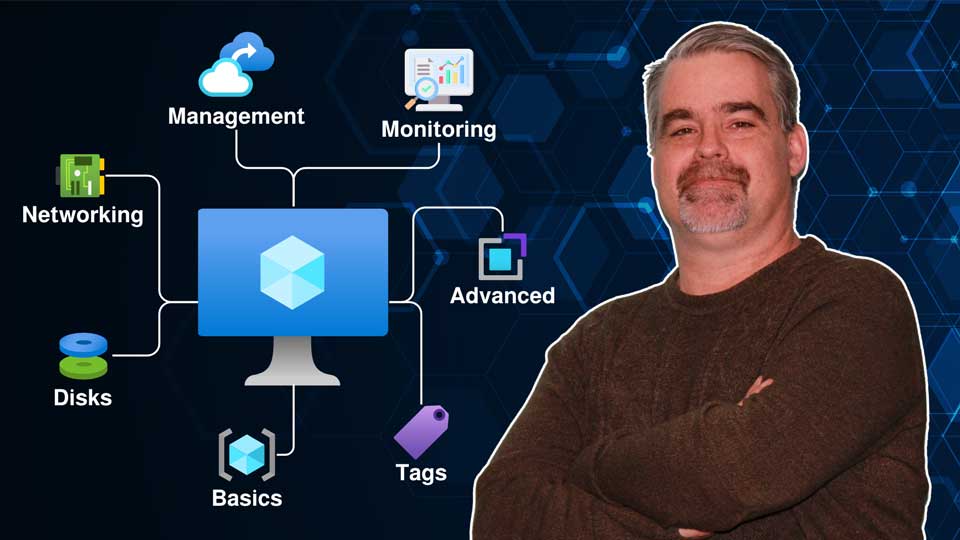This PREMIUM LAB COLLECTION allows you to practice basic deployment and configuration of common Azure services and features without having to ever pay a dime for an Azure subscription.
One-time payment. No recurring fees.
Are you ready to build confidence with Microsoft Azure by practicing real-world tasks in a hands-on environment? This Azure Skillbuilder Collection gives you direct access to a set of 26 guided labs focused on everyday Azure administration and configuration—no subscription required.
Each lab includes built-in audio and visual guidance, so you’ll feel like you have an instructor walking you through the steps while still learning at your own pace. You can pause, explore, and repeat as needed, making it easy to reinforce key skills.
Across this collection, you’ll perform common tasks such as deploying virtual machines, configuring storage, managing users and groups in Microsoft Entra ID, setting up networking components, and applying role-based access control. These are the same day-to-day skills IT professionals use to manage Azure environments in the real world.
This hands-on training is designed for anyone looking to practice practical Azure skills—from IT professionals preparing for certification exams, to system administrators new to the cloud, or even experienced engineers who want a safe place to sharpen their skills. By completing these labs, you’ll gain the practical knowledge and confidence to tackle core Azure tasks in production environments.

This module focuses on managing identities and access within Microsoft Entra ID. You’ll create and manage users, groups, and licenses, while also exploring how to configure self-service password reset and user properties. By completing these labs, you’ll gain the skills needed to securely manage identities in the cloud. These are foundational tasks for administrators supporting Azure or Microsoft 365 environments.
In this lab, you will learn how to create a security group within Microsoft Entra ID (formerly Azure Active Directory). Security groups are an essential part of controlling access to resources and applications in a cloud-based environment. You will explore how to create a security group, add members, and assign owners. By the end of this lab, you will have the practical skills needed to implement group-based access controls, enhancing security and simplifying user management.
In this lab, you will configure Self-Service Password Reset (SSPR) in Microsoft Entra ID (formerly Azure Active Directory). Self-Service Password Reset allows users to reset their own passwords without needing to contact IT support, reducing help desk workload and improving user experience. You will explore how to enable and configure SSPR, set up authentication methods for password recovery, and test the functionality from a user perspective. By the end of the lab, you will understand how to implement and manage SSPR to enhance the efficiency and security of your organization’s password management processes.
In this lab, you will explore how to manage user properties in Microsoft Entra ID (formerly Azure Active Directory). Effective user management goes beyond creating accounts—it involves configuring and updating user properties to ensure proper identity management and security. In this hands-on experience, you will learn how to modify key user attributes, such as company name, job titles, and group memberships. By the end of the lab, you will have the skills needed to effectively update and maintain user properties to meet organizational needs.
In this lab, you will learn how to assign licenses to users in Microsoft Entra ID (formerly Azure Active Directory) to ensure they have access to the necessary cloud services and applications. Managing user licenses is a key aspect of identity and access management in Microsoft Entra ID. You will explore how to assign licenses through both the Entra Admin Center and the Microsoft 365 Admin Center. By the end of the lab, you will have the skills to manage user licenses efficiently, ensuring proper access control for your organization.
In this lab, you will gain hands-on experience with Microsoft Entra ID by creating and configuring a new user account in the Microsoft Entra Admin Center. This process is fundamental for managing identities within an organization, and you will explore key features such as adding user details and configuring user properties. By the end of the lab, you will understand how to effectively manage user accounts in Entra ID, ensuring that users have the correct permissions and settings for accessing resources within your environment.
In this module, you’ll learn how to control access and enforce governance across your Azure environment. You’ll assign RBAC roles to users, apply resource locks, and add tags for organization and management. You’ll also work with Azure Key Vault to secure secrets and access credentials. Together, these labs will give you the ability to implement consistent policies and protect your cloud resources from accidental or unauthorized changes.
In this lab, you will learn how to assign Role-Based Access Control (RBAC) roles to users in Microsoft Azure. You will be guided through the process of selecting a resource group, assigning the “Virtual Machine Contributor” role to a specific user, and verifying the role assignment. This exercise ensures you can effectively manage access within a resource group, allowing team members to perform tasks according to their assigned roles while maintaining security and compliance.
Resource locks are a critical tool for preventing accidental or unauthorized modifications to important resources. In this lab, you’ll learn how to add and remove resource locks in Microsoft Azure. By locking resources, you ensure that they cannot be modified or deleted unintentionally. This lab guides you through the process of applying a “Delete” lock to a virtual machine, testing the lock’s effectiveness, by attempting to delete the resource, and then removing the lock.
In this lab, you will learn how to effectively tag resources in Microsoft Azure to better organize and manage your cloud infrastructure. Through a step-by-step process, you will tag multiple resources, such as virtual machines, and use the tags to filter and display resources based on their assigned tags. By the end of this lab, you will have a clear understanding of how to implement and utilize tags to improve the management and accessibility of Azure resources.
In this lab, you’ll learn how to create and deploy an Azure Key Vault, using the Azure portal. This lab provides step-by-step instructions, walking you through the process of finding the key vault service, choosing a resource group to deploy to, naming the key vault, and then deploying it.
This module covers the essentials of Azure storage management. You’ll create and configure storage accounts, file shares, and blob containers, and learn how to generate SAS tokens for secure access. These labs will show you how to store, organize, and secure data in different formats across Azure services. By the end, you’ll understand how Azure storage supports real-world workloads from simple file sharing to enterprise-level applications.
In this lab, you’ll learn how to create and configure an Azure Storage Account using the Azure portal. The lab provides step-by-step instructions, walking you through the process of setting up a storage account, selecting key configuration options, and enabling advanced features like geographic redundancy, network access controls, and blob versioning.
In this lab, you will learn how to create and configure an Azure File Share within an existing Azure storage account. Azure File Share allows you to set up a fully managed file share in the cloud, accessible through standard protocols like SMB and NFS. This lab will guide you through the step-by-step process of creating a file share, selecting appropriate access tiers, and reviewing important configuration settings. By the end of this lab, you will have hands-on experience creating a file share that is optimized for frequent data access and ready to be used for storing and sharing files.
In this lab, you’ll learn how to create and configure a blob container in an Azure Storage Account. You’ll go through the steps of setting up a new container, configuring access permissions, and enabling anonymous access for blob data. You’ll adjust network settings to allow public access to the container, ensuring that it can be accessed over the internet.
A SAS token is a secure way to grant limited access to storage resources within an Azure Storage account. It allows for time-bound, controlled access to specific resources such as blobs, files, and queues, without exposing the storage account’s access keys. This lab will guide you through the steps to create a SAS token, configure its permissions, set its access scope, and restrict access based on IP addresses, dates, and other parameters.
In this module, you’ll gain practical experience deploying and managing Azure Virtual Machines. You’ll learn how to provision new VMs, resize them to match workload requirements, and move them between resource groups. You’ll also configure scale sets for improved performance and availability. These labs build your confidence in handling one of the most common and versatile Azure services.
In this lab, you’ll learn how to deploy and configure an Azure Virtual Machine (VM) using the Azure portal. The lab walks you through the steps of creating a new virtual machine, configuring its settings, including availability zones, security options, and network configuration. You’ll also learn how to attach and configure disks for your VM, manage network access, and ensure that resources such as IPs and NICs are properly deleted when the VM is removed.
In this lab, you’ll learn how to resize an existing Azure Virtual Machine using the Azure portal. Resizing a VM is a critical task when you need to adjust the resources allocated to your virtual machine, such as increasing or decreasing CPU and memory to match workload requirements. The lab will guide you through the process of selecting a different size, applying filters to find the appropriate VM size, and resizing the VM.
This lab is designed to guide participants through the process of relocating a virtual machine (VM) within the Azure environment. In this lab, you’ll practice the steps required to move a VM and its associated resources to a different resource group, which is useful for organizing or restructuring resources within Azure.
A VM Scale Set is an Azure compute resource that allows you to deploy and manage a set of identical VMs. This lab walks you through the process of setting up the scale set, configuring auto-scaling based on CPU usage, and attaching storage to the VMs. In this lab, you’ll learn how to deploy and configure an Azure Virtual Machine Scale Set (VMSS) using the Azure portal. You’ll also configure network settings and management options to ensure smooth operations.
This module focuses on the core networking tasks required to build secure and connected Azure environments. You’ll create virtual networks, configure NSGs, and establish vNet peering for cross-network communication. You’ll also deploy load balancers and Azure Bastion to enable secure connectivity to your resources. By practicing these tasks, you’ll gain the knowledge to build resilient and well-structured Azure networks.
Virtual networks are essential for organizing and managing network traffic within the Azure environment, and subnets allow you to segment your vNet for better control over resource communication. This lab walks you through the process of creating a new vNet, configuring address spaces, and setting up subnets to meet the needs of different applications. You’ll also apply network security features like encryption and use tags to categorize your vNet.
By setting up rules in an NSG, you can define which traffic is allowed or denied based on factors such as the source, destination, and protocol. This hands-on lab will guide you step-by-step through the process of creating a new NSG, defining security rules, and associating the NSG with a subnet in a virtual network.
In this lab, you’ll learn how to create and configure Virtual Network (vNet) Peering in Azure. vNet Peering allows you to connect two virtual networks, enabling low-latency, high-speed communication between them as if they were part of a single network. You’ll walk through the process of setting up bi-directional peering between two virtual networks, ensuring secure communication and resource access across the networks.
An internal load balancer allows you to distribute network traffic among multiple virtual machines within a private network. This ensures high availability, fault tolerance, and scalability for your internal applications. In this lab, you’ll learn how to deploy and configure an internal load balancer in Microsoft Azure. You’ll go through the process of configuring frontend and backend pools, setting up inbound rules, and creating health probes to monitor your virtual machines.
Azure Bastion provides secure and seamless RDP/SSH connectivity to your VMs directly from the Azure portal over SSL, without requiring a public IP address on the virtual machine. Throughout the lab, you will deploy a Bastion service, configure it to work with an existing virtual network, and test your configuration by securely connecting to a virtual machine.
In this module, you’ll learn how to protect critical workloads with Azure backup and recovery solutions. You’ll create Recovery Services Vaults, configure Backup Vaults, and apply backup policies to virtual machines. You’ll also perform a full restore of a VM to understand how recovery works in practice. These labs prepare you to implement reliable business continuity and disaster recovery strategies in Azure.
A Recovery Services Vault is a critical resource for managing backup and disaster recovery services in Azure. You’ll be guided through the process of deploying the vault, configuring storage redundancy, and setting up private endpoints for secure access. In this lab, you’ll learn how to create and configure a Recovery Services Vault in Microsoft Azure.
Backup Vaults are critical components for ensuring data protection, long-term retention, and disaster recovery within Azure environments. By completing this lab, you will deploy a Backup Vault, configure redundancy and cross-region restore options, and ensure that your data is securely replicated and recoverable in the event of an outage or failure.
Azure Backup provides a flexible, secure, and cost-effective way to safeguard your virtual machines by creating automated backup policies. During the lab, you will set up a Recovery Services Vault, configure a backup policy, and assign that policy to selected virtual machines. This hands-on experience will help you understand how to establish a comprehensive backup strategy for critical VMs, ensuring their data and system state are preserved for both short-term and long-term retention.
In this lab, you will learn how to restore a virtual machine (VM) using Azure Backup, a crucial process for ensuring business continuity and recovering from data loss or system issues. You will step through the process of selecting a recovery point and performing a full VM restoration to recover the VM to a previous stable state. This lab provides hands-on experience with Azure’s robust backup and restore functionality, enabling you to manage and restore VMs efficiently in case of failures or errors.
One-time payment. No recurring fees.
💡 Not convinced these labs are for you yet? 💡
Get started with our
Azure Labs Base Collection
and try out a few labs at no cost.
This feature is available to labITpro Supporters only.
Fast lookup for orchestration modes, autoscaling, load balancing, updates & CLI.
| Mode | Profile | Best For |
|---|---|---|
| Flexible | Standard Azure VMs | New workloads (default) |
| Uniform | Identical VMs | Legacy large-scale workloads |
| Feature | Flexible | Uniform |
|---|---|---|
| Standard VM APIs | Yes | No |
| Mix instance types | Yes | No |
| RBAC per VM | Yes | No |
| Azure Backup | Yes | No |
| Site Recovery | Yes | No |
| Fault domains | 1–3 | 1–5 |
| Type | Layer | Best For |
|---|---|---|
| Internal LB | L4 | Backend pools |
| Public LB | L4 | External traffic |
| App Gateway | L7 | HTTP/HTTPS + WAF |
| Policy | Rollout | Use |
|---|---|---|
| Automatic | Batch | App can tolerate disruption |
| Rolling | Controlled | Gradual, managed updates |
| Manual | On-demand | Full control; explicit API calls |

Learn what you need to know to get started with Microsoft Entra ID with this easily-digestible 5-hour bootcamp from best-selling instructor, Thomas Mitchell.
Disable these ads by becoming a labITpro Supporter!

Want to learn about Azure virtual networks? In this quick-hitting explanation, you’ll learn what they are, what they do, and you’ll learn about key Azure vNet features.
Disable these ads by becoming a labITpro Supporter!
Have a question?
Ask The Author is available exclusively for labIT Pro Supporters. Become a Supporter for a nominal fee and get direct answers from the lab creator.

Want to know more about Azure VMs and all their settings? This brief micro-course takes you step by step through every option you’ll encounter when creating a Windows VM in Azure, so you know what it does and when to use it.
Disable these ads by becoming a labITpro Supporter!